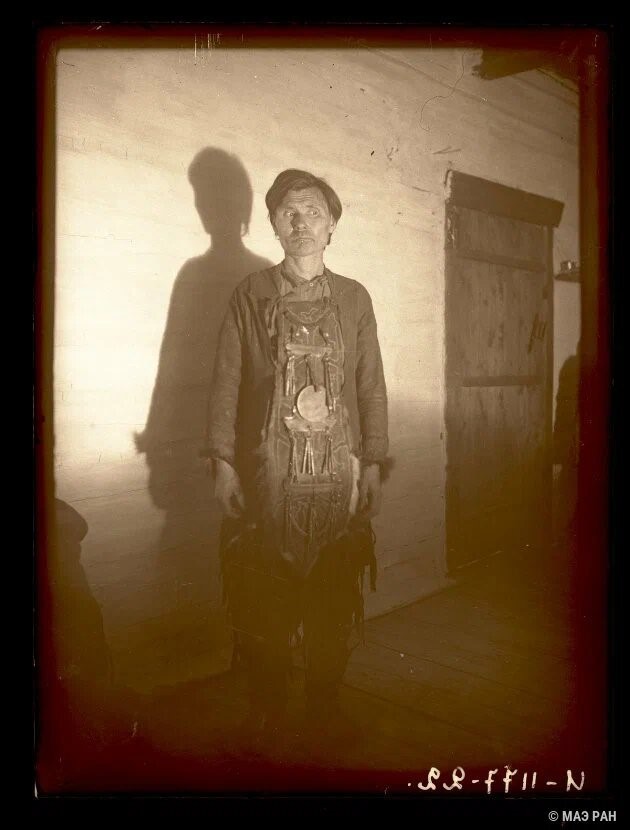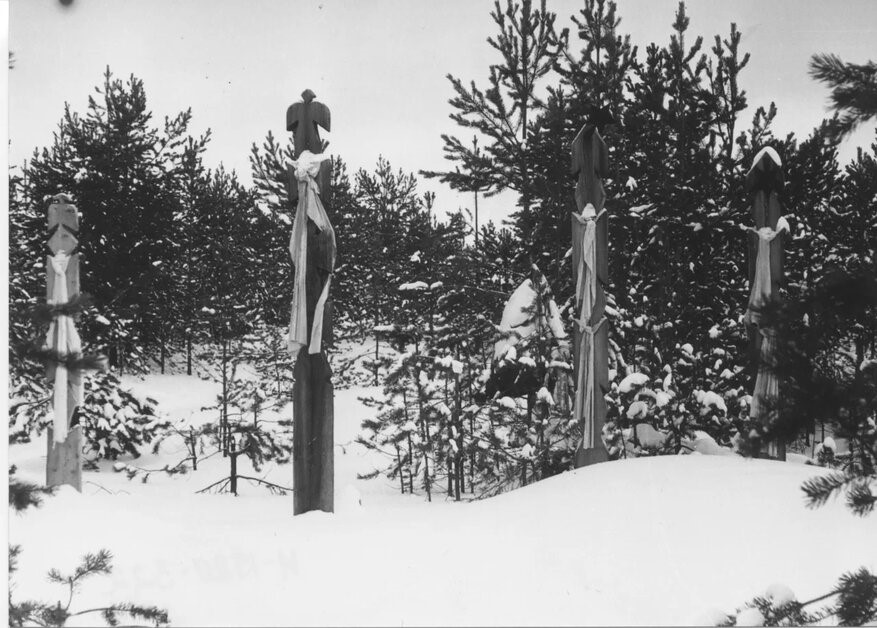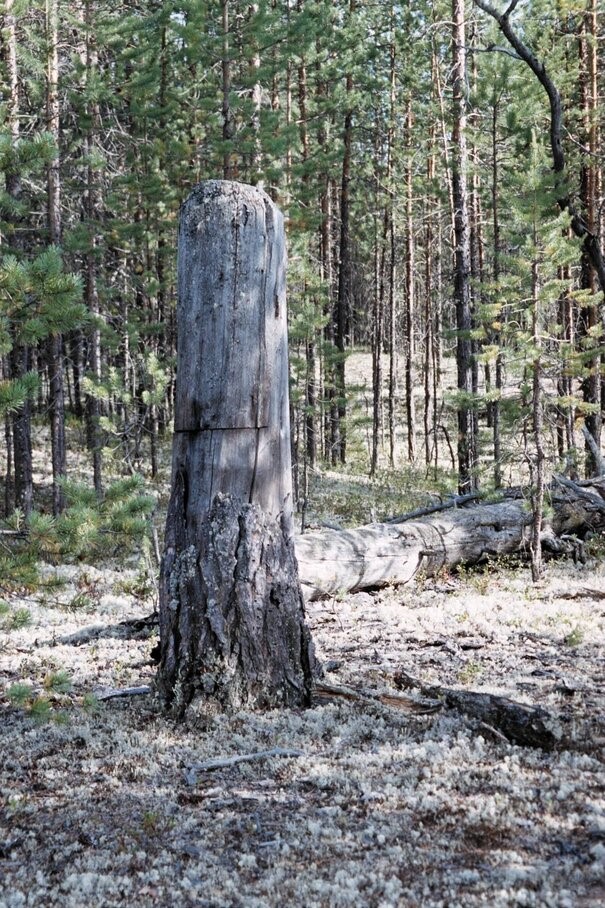|
|
Dr. Stepanova
Senior Research Fellow, Department of Ethnography of Siberia, Museum of Anthropology and Ethnography, Russian Academy of Sciences
|
Selkups. Spiritual culture
Selkups’ traditional worldview features several concepts of the universe. The vertical universe concept envisions a world that consists of three spheres: the sky, the earth, and the underground. These worlds are stacked vertically and called the upper, middle, and lower worlds. All three worlds were linked by the sacred tree (a birch tree or a larch) with its roots in the lower world. The trunk, therefore, represents the middle world, and its branches reach up into the sky. The horizontal universe concept envisions the three worlds connected by a river, where the riverhead is the upper world, its middle reaches are the middle world, and its estuary is the lower world. The sacred tree grew at the riverhead. People had possession of the middle world. The upper and lower worlds were seen as sacred spaces populated by the dead, including the long-dead ancestors and primal ancestors. All inhabitants of the world beyond the earth were seen as supernatural beings, spirits or lozs as Selkups called them.
Nom (Nop) is the main Selkup heavenly deity. Nom personified the sky, created weather, and provided food. This is a later image that has not been fully formed. The Old Woman preceded Nom in the role of the supreme deity of the Selkup pantheon; northern Selkups called her the Living Old Woman Ilyntyl Kota (Ylynta Kota, Imakota, Imilya). Ilyntyl Kota lives at the head of the sacred river in a sacred swamp. She is the mistress of the sacred tree with a hollow and roots going into the underground. In some beliefs, the Living Old Woman lives underground and at the sacred river’s estuary. Ilyntyl Kota was seen as a primal ancestor deity and was “in charge” of human life at every stage. She sent people’s souls to earth to be born in their mother’s womb, helped women in childbirth, and gave newborns a cradle made of birch or larch wood. Furthermore, she made sure young women were ready to be married, gave shamans their shamanic clothes, sent people ducks and geese from her swamp as food, was “in charge” of peoples’ fate, and saw their future. At the end of people’s lives, she gave each their coffin, a trough made of Siberian pine.
Selkups believed Ilyntyl Kota’s land to be home to many sacred holy objects: the sacred tree with the sun on its top and with different birds in its branches, the sacred swamp full of ducks and geese, a bear that guarded the roots of the tree that marked the start of the road into the underworld, a huge stone-and- iron house in a very hot rocky land with seven fiery suns that are so hot their heat melts the chainmail of fighting heroes; blacksmiths living next to the Old Woman etc. All objects are the Old Woman’s attributes and serve as her aspects: Ilyntyl Kota can be personified by a tree, a swamp/land, a stone, a blacksmith, the sun, fire, a bear, birds, etc. As the image of the Living Old Woman developed, it was split into several mythological characters that inherited one or several of her functions: The Grandmother of Fire-Flame; Tetty Imilya, the Lady of the Earth, who shapeshifts into a she-bear; ancestor birds; blacksmiths who can forge a new body for a hero; animated trees; stone-and-iron people and other figures: the Living Old Woman is an aspect or a “prefiguration” of virtually all spirits of the Selkup mythology.
Southern Selkups have the Old Woman Paya/Payaga, an analog of Northern Selkups’ Ilyntyl Kota whose image is either less developed or has been replaced to a greater degree with other figures. Paya/Payaga lives at the estuary of the river or in the sky; she is a small old woman who is “all covered with down and fur.” Folklore characters chance upon her at the time of danger. She can be reborn and serve as a creation force. Reindeer appeared from the fur shaven off her body and strewn around the swamp (alternatively, she spins reindeer tendons like yarn, and reindeer appear from them). She is reborn as a regular woman from the liver placed “on the other side” of the hearth. The Old Woman has a son and a daughter. Before getting married, the son sets up a trial for his bride to test her sewing skills. The bridegroom’s sister helps the girl pass the test. When the son and his wife have a child, the Old Woman takes the baby: his parents leave him in the forest, walk away, look back, and the only thing they see is a roiling whirlwind. In Southern Selkups’ beliefs, the Old Woman Paya merges with the image of the Old Woman Earth Chvechyt Paya whose animal aspect is the frog, the frog being the symbol of women in Selkup culture.
Northern Selkups’ Old Woman Ilyntyl Kota is grandmother to grandson Icha (Iy, Yy, Iya, I, Aya, Ichika, Ichakychyka, Ichekichika) meaning “boy,” “son.” She raised him after he was orphaned (in a later version, Icha is the son of Nom). Selkup folklore has a cycle of fairy tales about Icha. In those tales, he is a kind and good character, a pure-blooded Selkup, a protector of the Selkup people. He and his grandmother live at the riverhead or in the sky. Icha’s antagonist and antipode is the evil spirit Kyzy, his cousin who was fathered by a foreign warrior. Kyzy is the lord of the underworld and allegedly the source of all of Selkups’ trouble and misfortunes.
In the myths, the mission of the warring Icha and Kyzy is to provide an explanation for various elements of the Selkup universe: its society’s social makeup (each of the two heads one of the two intermarrying halves/phratries of the people); means of transitioning between the worlds; initiation of girls before marriage and their post-marriage death/rebirth; generational change, etc. The image analogous to Icha among the Southern Selkups is Itte, Idzhe locked in a confrontation with the (pan-Selkup) evil giant Pyunegusse.
Selkups had shamans who interacted with the spirits who could ensure their well-being. During their rituals, shamans transformed into their helping spirits and traveled to spirit worlds where they fought evil lozs who had harmed people. A loza vanquished by a shaman was imprisoned into a specially made image or into the body of a reindeer that henceforth was believed to be consecrated to the loz.
Selkups made figures of their ancestor spirits and erected them at their hunting grounds, kept them in their chums behind the hearth, in their attics, in sacred granaries, and transported in sacred sleds. To appease the spirits, they brought them offerings, for example, pieces of new fabric, coins, furs. During offering rituals, they fed the spirits and dressed them in new clothes. They asked the spirits to give luck in hunting and fishing, heal people, help in childbirth, help find missing reindeer, etc. Before the hunting and fishing season or in case of failed hunting or fishing, Selkups collectively brought offerings to spirits. Shamans generally were involved in making spirit images and the collective bringing of offerings.
Northern Selkups sacrificed to the spirits at the celebration of returning migratory birds that involved all the people. The celebration was preceded by a collective duck hunt and a collective feast; the ritual of animating new shamanic paraphernalia was timed to coincide with the celebration; the ritual was three to ten days long. Sometimes the same celebration was held in the fall when migratory birds were leaving.
The Selkup rite marking the killing of a bear was like a holiday; the bear’s body was butchered according to special rules, the meat was boiled, neighbors and relatives were invited to the meal; when eating meat, people invariably uttered the same formulas blaming ravens for the killing; divination using the bear paw was a mandatory element of the rite. In the past, the bear’s head and paws were placed on a table and decorated: if it was a she-bear, it was decorated with beads, ribbons, and pieces of cloth, if it was a he-bear, a small bow and arrows were placed next to it and hunters danced around the bear. Selkups believed that the soul of a long-dead relative came to them in the form of a bear; the soul had completed its life in another world and was ready to be reborn as a child from its own clan, and this rite called both a wake and a holiday meant both bidding farewell to the dead bear and celebrating the birth of a new person.
Narym Selkups connect the end of summer with the day of the moose peeing in the water and “freezing” and “cooling” it. This is the foundation of Pil Ed, a celebration the Selkups living in the village of Ivankino hold in the first days of August. The villagers also call this celebration nut narragot, literally “at the god’s above”: on this day, “the god moves to a different sky,” this is the day when the sun begins to gradually dip beyond the horizon.
































































